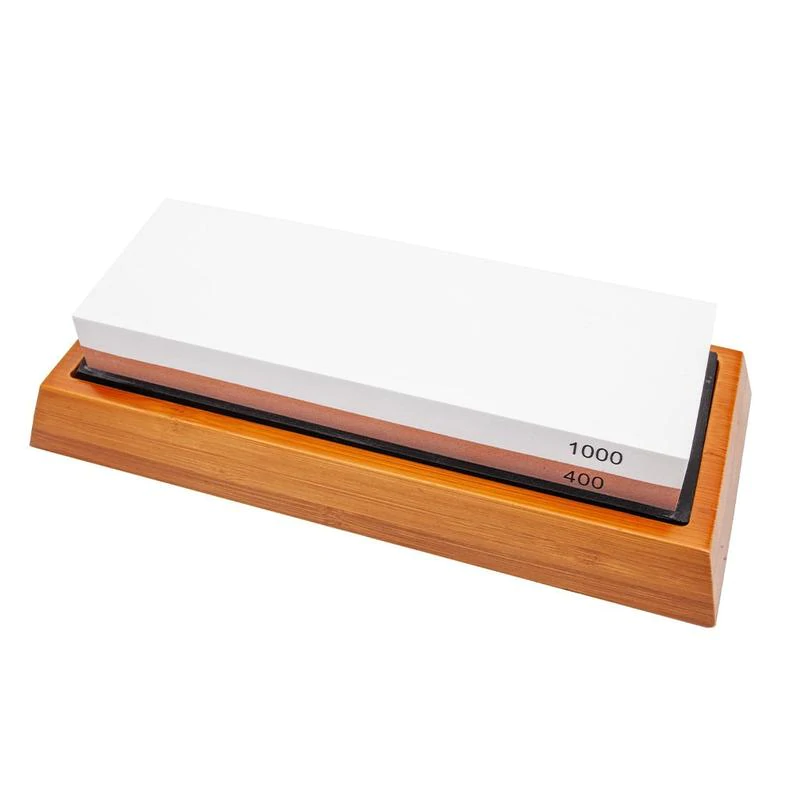Maintaining the sharpness of your knives is essential for efficient cutting and safety in the kitchen. You may have encountered the terms whetstone and sharpener and wondered about their differences.
Whetstones, also known as sharpening stones, are rectangular blocks used to sharpen and hone the edges of metal tools and implements. Sharpeners, on the other hand, can come in various forms, including pull-through devices, electric sharpeners, or even honing rods, each designed to maintain the blade’s edge with different mechanisms and levels of precision.
This article will discuss whetstone vs. sharpener more in detail and answer which one is a better tool and why. It’ll also cover detailed descriptions of the types of whetstones and sharpeners. Teaching you how to choose the best tool for your knife.
Table of contents
What is a whetstone
A whetstone, often referred to as a sharpening stone, is a type of natural stone used for grinding and honing the edges of steel tools and implements such as knives. These stones come in a variety of materials, including novaculite and silicon carbide, which are commonly used for their abrasive qualities that enable precise sharpening. These stones come in a variety of materials, including novaculite and silicon carbide, which are commonly used for their abrasive qualities that enable precise sharpening.
Whetstone grit levels
There are several different whetstones with varying levels of grit. Coarse, medium, or fine-grit stones are the most popular choices for sharpening knives and other blades.
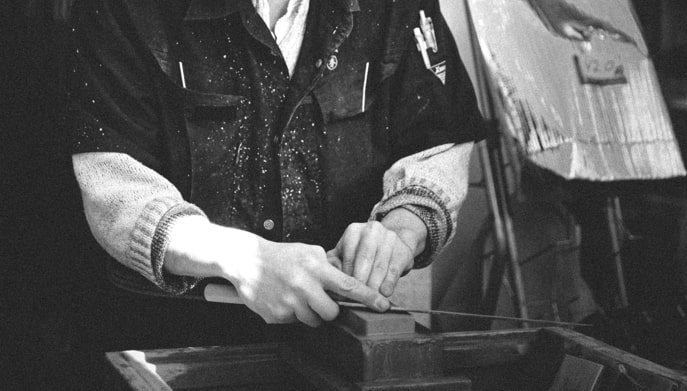
Coarse whetstones
A coarse whetstone is one with a grit level of less than 1000. These types of stones require the most skill and experience to use. They offer a coarse surface that is ideal for eliminating chips, cracks, and nicks. You can use a coarse whetstone to repair damaged blades or to sharpen extremely dull knives.
Do not use coarse whetstones to sharpen knives you plan to use for fine-cutting work. Their rough surface texture will damage the knife edges instead of sharpening them.
Medium grit whetstones
Medium grit stones range from 1000-3000 grit and are usually the most popular type for sharpening knives. They remove less material than coarse whetstones, but you can use them to sharpen moderately dull or chipped blades.
Fine grit whetstones
Fine grit stones are the perfect choice for honing knife edges. They are 4000-8000 grit and produce sharp blades that retain their fine edge, but they can’t repair severe damage to a blade’s surface.
Types of whetstones
When choosing which whetstone to use, it’s essential to know that not all stones are the same. There are natural whetstones and artificial types Each type varies in grade and consistency, so it’s essential to choose the best stone for your needs to get the results you want with less effort.
There are three basic types of whetstones;
- Oil stones
- Water stones
- Diamond stones
Oil stones
These are traditional natural stones made of Ozark Novaculite (silicone quartz) or Aluminum Oxide (corundum). Oil stones have their origin in Arkansas, where they were first quarried. They are natural rocks that require “conditioning” before use by soaking them in mineral oil or kerosene.
When you buy an oil stone, it includes a bottle of oil to get you started. Oils stones come in different mineral composites, which determine their coarseness. Norton fine Arkansas stones are the least dense and are perfect for honing the knife edges while polishing the surface.
Aluminum Oxide oil stones are coarser than the Norton fine Arkansas oil stones. They give off durable and smooth cutting edges and are a popular choice for many professional knife sharpeners. When speed is more important than how fine your knife turns out, oils stones made of silicon carbide are the best choice.
Water stones
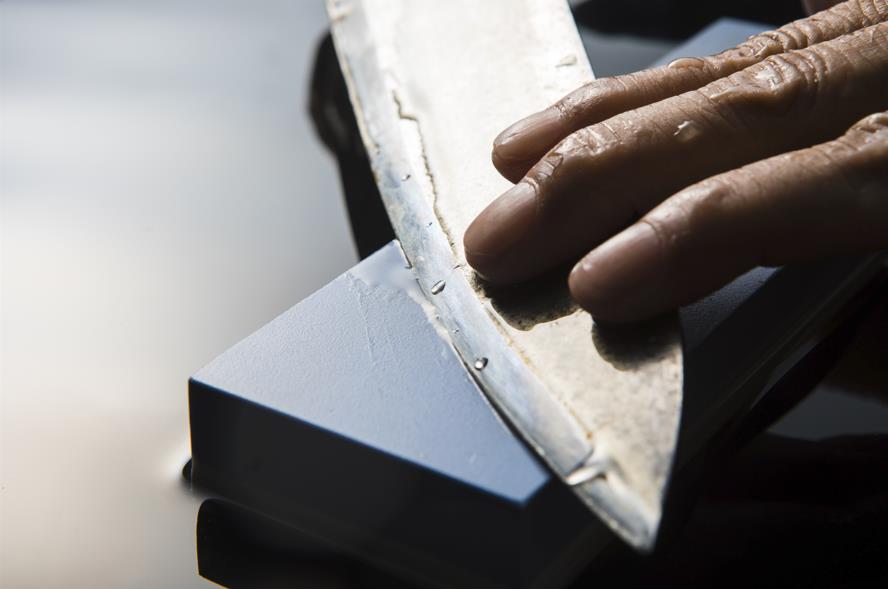
Water stones are also made of silicon carbide (green) or aluminum oxide (white). They are synthetic stones with softer grade particles that use water as a lubricant. They feature a high-quality composition that produces more refined and polished edges.
Water stones are easier to clean, and most knife enthusiasts prefer them over oil stones. Whether you buy a coarse or fine water stone, you have to soak it in water before use.
Handpicked for you
True cutting power in the palm of your hand
Diamond stones
For fast and effective sharpening, diamond stones are the best choice. They’re made of industrial-grade diamonds and metal alloyed together to create a strong and durable whetstone. They are more likely to stay flat across the entire whetstone, which provides you with a more even surface for sharpening.
You can choose to use a lubricant, but most times, it’s not necessary. Despite being the most expensive of the two stones, they are also the most durable.
Whetstone Kits
A whetstone sharpening kit usually contains multiple stones with different grit levels, allowing you to progress from rough grinding to a polished edge. Some kits include a flattening stone to maintain the whetstone’s surface.
Sharpening with a whetstone
Most chefs, professional knife sharpeners, and knife enthusiasts prefer to use a whetstone for sharpening knives. While critics may argue that sharpening knives with a whetstone is tedious and time-consuming, they cannot deny the superior quality of blades produced by these stones.
Pros of sharpening using a whetstone
- Whetstones are relatively inexpensive and last a long time.
- Whetstones preserve the blade’s natural edge while ensuring that the metal retains its strength and structure.
- They offer a more precise sharpening than electric or manual sharpeners
- They restore the original geometry of the blade’s edge with specific sharpening angles
- Whetstones give you more control over the sharpening process, allowing you to sharpen to your preference.
- Using whetstones is an art that encourages passion and patience
Cons of sharpening using a whetstone
- Whetstones require a tremendous amount of physical effort and skill for perfect results.
- The process is time-consuming and requires thorough attention to keep the blade at the correct sharpening angle.
- It’s hard to maintain a constant angle of sharpening on the whetstone.
- Whetstones are messy to use, especially when you need to use honing oil or water during sharpening.
Step by step guide to knife sharpening using a whetstone
What you’ll need:
- Sharpening stone
- Water or honing oil (optional)
- Spray bottle (optional)
- A kitchen towel or rag to clean excess oil
- A wooden block or stone surface to hold the knife during sharpening
Steps:
- Decide on the whetstone you’ll need for sharpening your knife. If you don’t know what grit level to choose, start with a medium one (1000-3000).
- Lubricate the whetstone surface. This ensures your knife slides across it smoothly and prevents excess metal from detaching and damaging the stone’s surface. You can use water, oil, or spray-on lubricants.
- Find a comfortable position for sharpening your knife. A few popular options include an arm’s length, a tabletop surface, or the floor.
- Hold your whetstone slab in one hand and lay it flat on a clean kitchen towel/rag to keep it from slipping when you sharpen your knife. Make sure that the stone is stable enough to shift around when you sharpen your knife.
- Hold your sharpening stone in one hand and place the heel of your blade near the top at a 20-degree angle to the stone’s surface. Make sure to choose the correct sharpening angle based on your knife’s blade shape.
- Keep the knife still as you push it across the whetstone from one end to another, as if you were cutting a thin slice of stone off its surface. Repeat this motion four or five times before alternating between both sides of your blade.
- Flip your knife over and repeat the same motion to sharpen the opposite side of the blade.
- Switch to a finer whetstone for honing if your blade has dents or bumps along its edge, but make sure not to use a stone with an uneven surface as it can damage your blade’s edge.
What is a sharpener
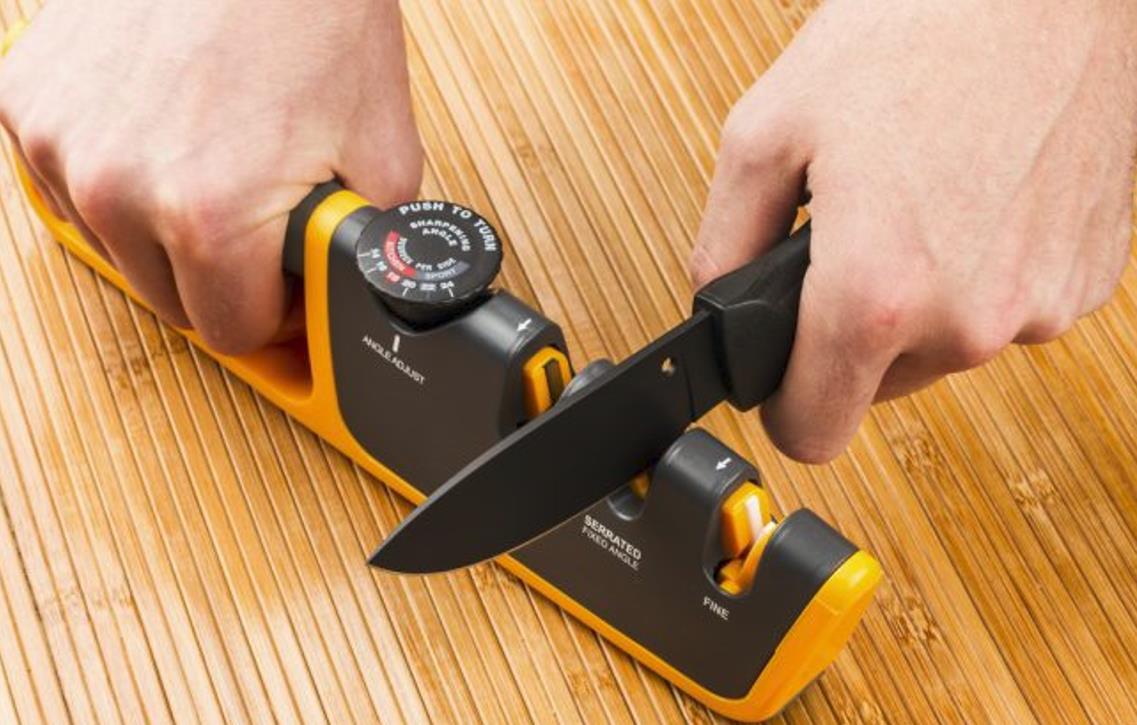
In essence, the term “sharpener” is an umbrella term that includes whetstones. However, within the scope of this comparison article, it specifically denotes a manmade tool capable of manual or electric operation.
The construction of sharpeners often includes abrasive materials like tungsten carbide, ceramic, or diamond coated surfaces. The choice of material influences the sharpness and longevity of the blade being sharpened.
Your choice between manual and electric sharpeners will depend on your specific needs, including the tools you’re sharpening, the frequency of use, and your preference for the convenience of an electrical device versus the control of a manual process.
Manual sharpeners
Manual sharpeners are knife sharpening tools that feature multiple stages and abrasive surfaces intended for different degrees of blade sharpening. These handheld devices come with removable and attachable guide rods that provide a predetermined angle when sharpening the blade to achieve the desired blade shape.
Of course, different blades require sharpening at a different grade, which is why handheld sharpeners come with multiple stages. You can use the lowest setting for regular maintenance and touch-ups, while the highest stage is meant only for blade reshaping after extensive use. Some models include a honing stage to remove dents and an extra-fine stage for honing and polishing.
Manual knife sharpeners are versatile and dependable, but they require some level of practice to master. It takes a certain degree of control to keep the blade at the correct sharpening angle when pushing it across the abrasive surface. Some people consider manual sharpeners as the best knife sharpener for beginners.
Electric knife sharpeners
Electric sharpeners offer convenience and speed. They feature two main parts: the motor, which rotates the sharpening elements, and the sharpening module, which includes an abrasive wheel. Electric sharpeners also have two or more stages, depending on their types; coarse and fine.
They are more expensive than manual sharpeners, but they are worth the price. They produce consistent sharpening results and some come with various features, including slots for sharpening serrated knives, adjusting sharpening angles, and removing dents. Some models allow you to adjust the sharpening speed and switch between different wheels.
Sharpening with a knife sharpener
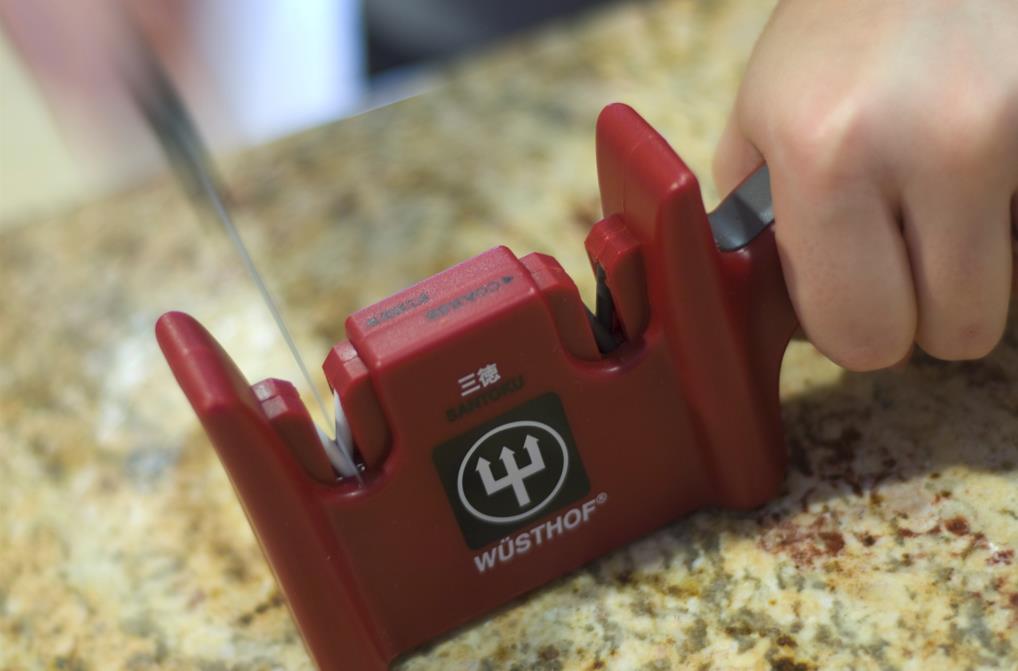
While manual and electric sharpeners make the sharpening process a breeze, some people still find the process challenging. They prefer to stick with the traditional manual whetstone for sharpening their knives.
Pros of sharpening with a knife sharpener
- It provides a quick way to sharpen knives as it requires less effort from the user (especially for electric knife sharpeners)
- It’s easy to use and does not require a high level of sharpening skill.
- Manual knife sharpeners are portable and don’t take much space.
Cons of sharpening with a knife sharpener
- Manual and electric knife sharpeners don’t give you complete control over the blade’s sharpening angle, leading to inconsistent results.
- The process of passing your knife over the abrasive surface may cause damage to the blade, including micro-chipping and loss of material.
- Electric knife sharpeners come with a hefty price tag.
- If not handled properly, they are prone to damage (e.g., using electric knife sharpeners in wet conditions can cause a short circuit).
Step by step guide to using a knife sharpener
Given that there are two types of knife sharpeners, it’s crucial to understand the process and proper use of each to achieve the desired sharpness level.
Manual knife sharpener
- Place the knife sharpener on your work surface for stability.
- Hold the knife handle in your dominant hand and the knife sharpener handle in the other, ensuring that the handle is on your non-dominant side. (Some don’t require the specifics to hold the handle)
- Ensure your fingers are behind the heel of the blade to avoid getting cut.
- Begin with the coarse slot if your knife has significant damage on the blade. If not, begin with the medium or fine slot.
- Pull the blade through the first slot, starting from the heel to the tip. Start with a sweeping motion and finish with a vertical one at your preferred sharpening angle.
- Ensure you lift the knife up to follow the contour as you approach the tip of the blade.
- Repeat this motion four to five times, working your way up the coarse slot until you develop a burr.
- Turn the sharpener to the fine slot and repeat step 5 four to five times until the blade is smooth.
- Clean the blade by wiping it down with a clean rag.
Electric knife sharpener
- Plug the electric knife sharpener into an electrical outlet and turn it on.
- Hold the knife with your dominant hand with the blade gently resting on the sharpener’s surface.
- Place your knife in the coarse slot at your preferred angle (20 degrees for Japanese knives or 15 degrees for German knives).
- Draw the blade through the slot, starting from the heel to the tip. Keep your fingers behind the blade’s heel to avoid injury.
- Raise your knife as it approaches the tip to maintain the knife contours.
- Turn the sharpener to the medium slot and repeat step 4 four to five times until you see a burr on your blade.
- Turn the sharpener to the fine slot and repeat step 4 four to five times until your blade is smooth.
- Clean the blade by wiping it down with a clean rag.
Whetstone vs sharpener
| Whetstone | Knife sharpener | |
| Control | Gives you complete control of the knife during the sharpening process | It limits your control over the knife sharpening process |
| Level of skill required | It requires a high degree of skill and precision for excellent results | Any novice with interest in knife sharpening can use a knife sharpener |
| Convenience | It’s a strenuous process if the knife was extremely damaged (chipped or dented) | The process is automatic for electric knife sharpeners and requires little to no effort for manual knife sharpeners |
| Result | Recommended by most chefs for its perfect results | A knife sharpener doesn’t guarantee excellent results as passing the knife over the abrasive surface can damage the knife. |
| Price | Whetstones are inexpensive and can last a very long time | Electric knife sharpeners are expensive. Manual sharpeners are slightly cheaper but expensive versions are also available. |
Key takeaway
It’s important to remember that both tools offer benefits and drawbacks. Whetstones allow for more control over results and are better suited for professionals. On the other hand, manual and electric sharpeners offer a quick fix when speed is essential.Whetstones and sharpeners are essential tools for improving knife sharpness. While professional chefs prefer to use whetstones, beginners will do just fine with sharpeners. Visit our store for an easy-to-sharpen handmade kitchen knife.

